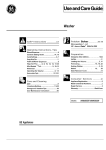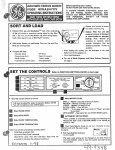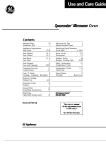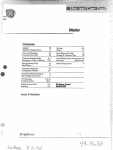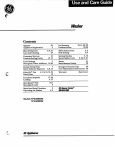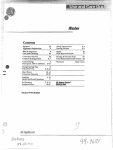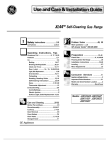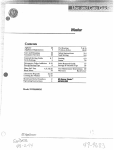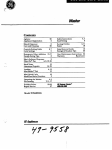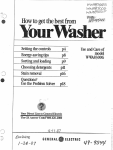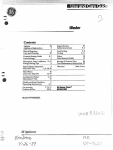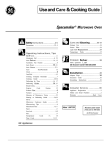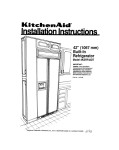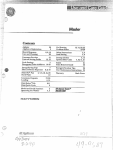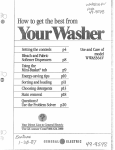Download GE WWM620M User's Manual
Transcript
Agitator Appliance Registration 22 2 Fre-Treating Problem Solver Care and Cleaning Consumer Services 22 23 SafetyInstructions Soak Setting 3,4 5,8 Sorting Stains 4,9 16 Controls Setting Guide CycleSettings 6,7 5 Detergents, Other Additives 11-15 Energy-SavingTips 5 Filter-Flo@Pan Hard Water 4,& 10,22 14 Limestone Deposits Loading the Washer Modeland Serial Numbers Operating Instructions Model WWM620M Stain RemovalGuide Storage &Vacation Tips 17 22 User Maintenance Instructions 22 Warranty Back Cover 12,22 4,10 2 4,5 7,9,15 18-22 GEAmwer C@Me@ 88a62&280@ EYOU NeedSetiee tm Read book carefu~lyo It is intendedto helpyou operate and maintainyour new washer properly. Keep it handy for answersto your questions. If you don’tunderstandsomething or need more help, write (include your phone number) Consumer Affairs GE Appliances Appliance Park Louisville, KY40225 If you receiveda -Wed Wsher.. . Immediately contact the dealer (or buflder) that sold you the washer. save the ad ~O~~ye Before you requestSertiee. .. checkthe Problem Solver on pages18through 22. It lists causes of minor operating problems that you can correct yourself. Toobtaina Spanishlanguage versionofthisbook,call GEAnswerCenter@ 800.626.2000 consumer informationservice. Para obtenerla versionen espafiolde estemanual, name a GE Answer Center? servicio de informacibn para el consumidor, telifono 800.626.2000. FOR YOUR SAFEW Toobtainservice,seethe ConsumerServicespagein the backofthisbook, We’reproudofour servicea~~d wantyoutobe pleased.If for some reasonyouareI]othappywiththe serviceyoureceive,herearethree stepsto followfor furtherhelp, FIRST,contactthepeoplewho servicedyourappliance.Explain whyyouare notpleased.In most cases,thiswillsolvetheproblem. NEXT,if youare stillnotpleased, writeallthe details-including yourphonenumber—to: Manager,ConsumerRelations GEAppliances AppliancePark Louisville,Kentucky40225 FINALLY,if yourproblemis still notreso~ved,write: MajorAppliance ConsumerActionPanel 20 NorthWackerDrive Chicago,Illinois60606 Wrik dow~l themodel andseriai numben. You’llfind them on a label on the lower Iefi side near the front. These numbers are also on the Consumer Product Ownership Registration Card that came with yourwasher.Beforesendinginthis card, pleasewritethesenumbers here: ModelNumber serial Nllmber Usetl~escnumbersinany correspondenceor servicecalls co~~cerning yourwasher. ., -., \ (.1 K! ..__-- .: -: IMPORTmT Sm fire,electric shock, Orinjuryto pmm Whenmhg yowappumce~ fotiow basic pmutiom, hclutig the following: @Usethis applianceody forits intendedpurpse asdescribedin thisUseandCareBook. @Thiswashermmt beproperly tid mldlmW k a~ortice withthehstilation htructiom beforeit isused.Ifyoudidnot receiveanhstiation hstructions sheetwithyourwasher,youcan obtainonebycontactingtheservice locationnearestyou. —Roperly groud to cotiorm withall govertingcodesand ordinances,Followdetailsin InstallationInstructions. –Instill or store whereit ti~ not beexposedtotemperaturesbelow freezingorexposedto the weather. –Connect toaproperlyrated, protectedandsizedpowersupply circuittoavoidelectricaloverload. –Connect toade~uate~lumbin~ TYINSTRUCTIONS aclose supervision is necessary ifthkapplianceis wed byornear children.Do notailow chil&en toplay inside, onor with tMs apptianceoranydsearded appUance.Disposeoftisearded appliancesandshippingor pacMngmaterialsproperly. Beforetiscardhg a washer9or removingfromservice,remove thewasherlid. @Keep au laundryaids(suchas detergents,bleaches,fabricsofteners, etc.)outofthereachofchildren, preferablyinalockedcabinet. Observe allwarningsoncontainerlabelsto avoidpersonalinjury. ~Keeptheareaaroundand underneathyourappliancesfree fromtheaccumulation ofcornbustible materials,suchaslint,paper,rags, chemicals,etc. @Keeptheflooraroundyour appliancescleananddrytoreduce thepossibilityofslipping. @Tominimizethepossibility ofelectricshock,unplughis appliancefromthepowersupply beforeattemptinganymaintenance or cleaning(excepttheremovaland cleaningofthelintfilter). N~E: TurningtheCycleSelector knobto anOFFpositiondoesN~ disconnecttheappliancefromthe powersupply. e DoElothmper WtihControlse @Donotoperatethisappliance ifit is damaged,malfunctioning, partially disassembled,or has missingor brokenparts, including a damagedcordor plug, ~Neverclimbon or standonthe washertop. QDo Ilotwashfibexgi~s~ art~m~~e~ in yourWas:ler,S!”tin [email protected]. resuh froimtilere~m~inir]g ~3a,rti.c;.es thatima~ ‘Qe p icked. ~ ~p b yt:~@{->j j~g ,-~” tlLlzl13.g Subseau.ent !.ihe. i!ei..’:’A ~ vJas, ,, Stietyktruetiom (Continual) * The Iaundryprocesscm reduce FOEwasherQpratiom” avoidsucha result,thegment mnuticturer’scareinstructions Shoddbe fouowd veryCarefiuy. @Donotleavewasherlidup dutig cycle.Ttis wdl stoptie washandSpk actionad preyent completionoftie ~cle. tieflame retar’darlqOffabrics.To HOW b TmSE msTRudTIoNs opemkyourclotheswasher W~G—To tiae I-WA~ rad SAW reducethe fik SmTY ~o ~ Sort clothes carefilly by fabric type, weight, color and amount of soil, according to instructions on page 9. @Remove FiIter-FIo@pan. The underside of the lid is a good place to put the pan while loading or unloading clothes. offire, eIwtrEc shock, or injury topemons, beforeoperating this appliance. mSmUCTIONS @ @.@— @— N~E: Do notusetheFilter-Flo panas a washbasket.Do notput anyitemsto be washedin the Filter-Flopan. ~ Seepage8 forinformationon howto useBleachDispenser.For informationon bleachesand fabric softeners,seepage15. ~Closethe lid. Washerwillfill, butnotagitateor spinwith thelid open. @ SelectWmh/Wse Temperature. Coldrinsewillbe automatically providedwithuseof Permanent PressandKnitsCycles.(An extendedcool-downsprayrinse andcoldwaterdeeprinse are providedto minimizesettingof wri~es.) @ PushCycleSelectorhob in andturn clockwiseto yourselected washsetting. I ~Addmeasuredamountof detergent.Seepages 11through15 for informationon deterge~ltsand oti~erlaundryadditives. setting the contro~s Use theControlsSettingGuideon pages6 and 7 to helpyoumakethe properse~ections. @ SelectWash/SpinSpeed. @ SelectWaterLevel. SMALL:Washeris lessthan 1/3 fill of clothes. MEDNM: Between1/3and 1/2fiti. LARGE: Between 1/2and 2/3 fill. EXTRA LARGE: Over 2/3 fill. @ ~~~lcycleSelectorhoboutto s~ the washer.Ifyouwishtochmge settingafterwasherhas st~~d, push CycleSelectorknobinto stopthe wmherad resetto tie newposition. Settingcan be chmgedat a~~y time. Enemy-sating Permanent Ressand If yourclothes and householditems don’tlook clean and fresh afier washing,you will probably re-wash them ...and that meansyou’llwaste energy.Rememberto sort your clothescarefilly, and load them properly,select correct cycles,use enoughdetergentand choosea watertemperaturewarm enough to releaseand get rid of soil, mti cycles— Provideslongerwash timefor mostcottons,linens and workand playclothes. For permanent press and knits loads such as shirts, blouses, dresses and similar wearing apparel with normal soiling.An extendedcool-downspray rinse is providedto minimizewrinkling. SOIL @ tips LIGHT NORWL ~ HSAW @UseHot Wash—upto 150°F.—on a regularbasis only when washing heavily soiled articles-such as work and play clothes. soakcycie— Use with most soaking aidsto Ioosenembedded soils and stains. Etim clean cye~es with Aub Etira Mme— For modernfabricswithheavyor oilysoil.A secondrinseis provided to helpremovethe additional detergentthat is requiredforthese soils.Seepage13. 1= ml uloa 10Slm mn m SIW I * Under normal soilconditions, wash in water above80°F. (V”C.). This.generallymeans using the Warm Washtemperature setting on Yourwasher—temperatures ap~roximately90°F.~o1lO°F.or hand comfortable.If you notice that soil has accumulatedafter severalconsecutivewashings,use Hot Washoccasionally,if safe for fabrics. @Alwaysrinse in Cold Water.The temperature of the rinse does not affect cleaning. @Tryto wash Iess ofien. Save articles of the same type of fabric untilyouhavea fullload. I I Oemg nlJTo [XTRA RINSE ,“,, <floe ,“ ~ If you must wash smaller loads, adjust the amount of water. Small loads shodd havelowerwater levels. Extra Clean Cycles s,,.,.,, s” ,0s,”, what Happeminmeh setting (Approximate Minutes) I e Wash in off-peak utility hours. Yourlocalutilitycantell youwhich are the off-peakhours. ~ Use Normal Spin speed to remove more water and help lessen drying time. The dryer will remove any wrinMes caused by Normal Spin. Controksetting Guidefortifferent fabricsand Ioa& had sDeed Wwh water TemperatMr& Cottons and Linens White/Colorfast Bright/Non-colorfast NormaI Normal Hot or Warm Warmor Cold Regular Cycles Regular Cycles Normal Setting Normal or Light Soil Setting WorkClothes Heavy soil Normal Hot Heavyor Normal Setting Averagesoil Normal Hot or Warm Extra Clean Cycles with Auto Extra Rinse Regular Cycles Normal Hot Heavyor Normal Setting Gentle Warm Extra Clean Cycles with Auto Extra Rinse Permanent Press and Knits Cycles Normal Warm P. Press Setting 3entle Warm Permanent Press and Knits Cycles Permanent Press and Knits Cycles Silks, Wools; Blends of Silk and Wool ~entle Narm Permanent Press and Knits Cycles Knits Setting Rayonand Acetate lentle Warm Permanent Press and Knits Cycles Knits Setting Down-filled garments, if machine washingis recommended Gentle Warm Permanent Press and Knits Cycles P. Press Setting Baby Clothes—Sturdy,such as Diapers, Nightgowns, Shirts, Pads, Sheets, Receiving Blankets, Coveralls Normal iot Regular Cycles Normal or Light Soil Setting, depending on amount of soil Baby Clothes—Delicate 3entle Varm Permanent Press and Knits Cycles P. Press Setting 1 i min. soak then Normal Varm Regular Cycles Light Soil Setting Blat]kets-Synthetic, Electric 5 min. soak then Normal {arm Regular Cycles Light Soil Setting Curtains-DO N~ MACHINE WASHFIBERGLASS Gentle Permanent Press and Knits cycles P. Press Setting Permanent Press and Knits Cycles P. Press Setting wmh/spir Permanent Press, Treated Cottons, Blends with Cottons Heavy or oily soil Averageor light soil Synthetics-Polyester, Nylon, Acrylic Knits and WovenFabrics Sturdy Delicates Blankets-Wool, Part-Wool, Cotton . 3 Chenille Bedspreads, RtJbcs*:~: cycle I - Gentle Hot or Warm Slipcovers, Draperies, Bath Mats and Rugs*+: Normal Hot or Warm Denims (espccial]y Indigo Blue Jenns) and other fabrics that bleed Norma] . ~c~rm PiIlows — setting Normal Setting P. Press Setting P. Press Setting — I Regular Cycles Normal Setting Regular Cycles Normal Setting Permanent Press and Knits Cycles Knits Setting I I Permanent Press and Knits Cycles F I [ P. Press or Knits Setting, depei]ding 011amount of soil (“~’) ; \ .— —.. Liquid chlorine type. Only non-chlorine bleach when needed. White or colorfast, liquid chlorine type. Non-colorfast, only non-chlorine bleach when needed. If colorfast is unusuallysoiled, use hot water. Use maximumdetergentrecommendedin guide on page 13.Use Extra Clean Cycles with AutoExtra Rinse, Heavyor Normal Setting.SWpage 5, White or colorfast, liquid chlorine type. Non-colorfast, only non-chlorine bleach whenneeded. Small loads reduce wrinkling. Use maximum detergent recommended in guide on page 13, Use Extra Clean Cycles with Auto Extra Rinse, Heavy or Normal Setting. See page 5. Whiteor colorfast, liquid chlorine type. Non-colorfast, orIlynon-chlorine bleach whenneeded. If unusually soiled, use hot water. Use maximum detergent recommended in guide on page U. For heavy or oily soil on sturdy garments, use Extra Clean Cycles with Auto Extra Rinse, Heavy or Normal Setting. See page 5. Small loads reduce wrirdding, dobleach Wash only if recommended by the garment manufacturer. Follow instructions carefully. eldom needed. If needed, use ordy on-chlorine bleach. Wash in your washer only if recommended by the garment manufacturer. [obleach Wash frequently to fluff up the down and retain the garment’s warmth. Wash separately. Wet down gives off an odor which maybe absorbed by other garments. Odor disappears when garment is dry. Treat heavily soiled areas with liquid detergent or paste made of water and granular detergent. Close zippers, Wash2 or 3 at a time or add towels to balance, GARMENT MUST BE TUMBLE DRIED. ‘biteor colorfast, liquid chlorine type, Youmay prefer to use a mild-type detergent. Do baby clothes separately. Pretreat spots. Rinse diapers, nightgowns, pads and sheets after use. Keep diapers in a covered pail of cold water and conditioning agent like Borateem brand. Ily non-chlorine bleach when needed. Youmay prefer to use a mild-type detergent. Do hand-knit garments by hand. Use maximumdetergent recommended in guide on page 13. —— ) bleach Fill washer, add detergent and allow to dissolve before adding blanket. Do one blanket at a time. Pretreat heavily soiled spots with liquid detergent. )bleach On electric blanket, sew a strong piece of cloth over plug to protect blanket and washer from ~amage. Do one blanket at a time. Pretreat heavily soiled spots with liquid detergent. ]ite or coior~~st,Jiquid chlorine type. Vacuumout loose dirt before washing. Iitcor colorfast, liquid chlorine type. If unusually soiled, use Normal Wash/Spin Speed. ite or colorfast, liquid chlorine type. I Wash only 2 or 3 rugs or mats at one time. Shake before washing to remove excess dirt. Por new “indigo blue” jeans, wash at least 3 times in very small loads with full water fill. Jeans need ample room to move to avoid white lines at creases. May discolor plastic washer parts. Subsequent washings will reduce discoloration, but will probably never eliminate it. The stained pafls will not discolor subsequent washing loads.’ - ‘-~FLuFF(NOHeat) }Icach .-.~ ‘icach ——..—.............__________ j ~ ~ ~ I Pillows are made ofdiffercnt rnaterials–dacron, fiber, foam, polyester, natural feathers and — down. Many pillows can be machine washed, but tnanufacnirers’care labels n-z~jsf befollolved car<fi{lly.If washing is recommended, check pillows for weak seams or holes and mend to prevent escape of feathers or filling. Fill washer, add detergent and agitate for several minutes to dissolve dcterge[~t,~,dd Iwo pillows at a time to balance load. Use hi~h water level. :_________ Howtowe the BIeaehDkpemer Howtousethe FabricSoftener Dkpemer I NOTE: Do not usethe Fiber-Flo pan as a wash basket. Do not put any items to be washed in the Filter-Flo pan. Do not place detergentpackets in the Filter-Flo pan. Howtomethe soakcycle ~ Use this dispenser with liquid bleach only. If you prefer to use powderedbleach, pour it into the wash basket along with your detergent. Do not put powdered bleach into the bleach dispenser. ~ Measure bleach carefully. Here are some recommended amounts: LARGE WATERLEVEL—1% CUP (310ml)liquid ~ Position the Fabric Softener Dispenser on the Filter-Flo pan. @Pour manufacturer’srecommended amount of fabric sofiener into a standard measuring cup. @Addenough water to fill the cup 1/2full. @Pour the diluted sofiener into the dispenser. Q@@a AUTOEXTRARINSE Ext @The fabric softener will automatically be dispensed at the proper time. * “SOAK~CLE” temperatureis controlledbytheRinsetemperature switch.~f a warmsoakisdesired,set theWASH/~SE TEMPEWTUM. ~ Do not stop thewasherduring switch to “HOT/WARM~’) @DonotoverfiIIorallowdispenser to overflow.Avoidsplashing. the firstspin. This will cause the dispenser to empty too soon. @~f a hot soak is desired, set the Undiluted bleach can cause fabric damage. ~Do not use the Fabricsoftener Dispenserwith the soak Cyclee @Never pour undiluted Iiquid bleachdirectiyonto clothesor intothe washbasket. @If the rinse dispenser gets clogged, soak it in a solution of 1 cup water and 1 cup alcohol. SMALL WATERLEVEL–213 CUP (170ml) liquid ~ Pour measured amount of liquid bleachdirectlyintobleach dispenser. WASH/NNSETEMPERATURE switchto “H~/WARM” and turn the CycleSelectorKnobto “NORMAL”in the RegularCycles. Startthe washer.Afier washerfills and beginsto agitate,pushin the CycleSelectorKnoband turn to “SOAK~CLE~’ Pull outthe CycleSelectorKnobto complete the cycle. washerto fill and agitatefor a few minutesto dissolvethe soaki~lg agent.Then pushin the Cycle SelectorKnobto stopthe washer (keeplid closed)and allowto soak for as longas desired.Afierdesired soakperiod,pul~out thecycle SelectorKnobto completetheqcle. -. tosortthe How clothes Sortby soil It paystocheckal?’nd prepare clothes forwashing. Separa @Empty pockets, brush out cuffs, zip zippers, snap snaps, hooks and buttons. from from 17 * Lint Collectors LINT COLLE~RS— such as man-made fibers and napped fabrics like velveteenand corduroy —attractlint. These must be washed separately. For more information on lint control, see page 18. Check all items for areas of heavy soil or stain. M::;m. s Removestains. For STAIN REMOVAL GUIDE,SEEPAGE17. from ● H::;y Turn Poly Knits inside-outto minimizefabric surface damage. soaking and Pre-treating— a good waytolmsen deep soils and stiins. m A thorough soakingwith detergent sortbyColor or special soaking agent is another wayto remove heavy soils, embedded dirt and even some stains. Separate Soakingcan be either a completely sortby fabric Separate . 13 LINT PRODUCERS— Such as terry towelingand chenille—give up lint. ~ Do any necessarymending—rips, hems,tears. \ Whites/ . Cottons & Linens from separate washing step or a preliminary step to a complete wash cycle. For detailed information on how to soak in your washer, seepage 8. FOR INFORMATION ON so~m~ AGENm, SRE PAGE15. 13 from from ~ Pre-treat heavy soil by rubbing in a small amount of liquid detergent or a pastemadeofwaterandpowderd detergent or soap. For best results, wait 1/2hour before washing. from Darks j from from .— L–u.., ,—--__.— -. ! ‘-.> t i “ -’ Special recomen&tiom forw=- prmanentprms notIRavea d~er. If you are machine-washing Permanent Press cIothesthat you plan to line dry or drip-dry, use extra care to minimizewrin~ing in the wash process: @Be careful not to overload washer. Permanent Press clothes must haveample room to move freely. A Medium size Permanent Press load is the largest that should be washed. @Use more water than you would for a regular load. Use a Medium WaterLevel for a Small Load; an Extra Large Water Level for a Medium Load. @Removeclothes promptly as soon as washer stops and hang immediately. @TO minimize wrin~ing, use Gentle Wash/SpinSpeed. if you do .* :&* @ $. @Loadclothesdry. ~ Takea properlysortedgroupof clothesanddropthemlooselyin the washbasketin thisorder: Large Items—1ike sheets.Do not wraparoundtheagitator. SmallItems–1ikewashcloths. Thisillustration,withclothesjust reachingthe ClothesRetaining Ring,showsa properload. Clothes haveampleroomto movebecause theyare notpackeddown,nor wrappedaroundthe agititor. Clothesare loadeddry sincewet itemsare aptto packdownwhich encouragesoverloading.Thissize loadrequiresa fullwaterfill. To add items afterthe washer has stirted. ~Turnoffthe washer. ~Carefullyremovetie Filter-Flo pan. ~Addanyadditiondarticlesby submergingnextto the agi~tor. QReplacethe Filter-Flopan and restartthe washer. Wilat is the best sizeload of Clothes—largey medm, or Smail?save time,ene~y and dete~en$ byavoidingextrause of the washer.Tryto washa fi~llload of clothes.If youcan it is betterto saveclothesuntilyouhavea fill load. If youmustwashsmaller loads, savewate;,energyand detergentby adjustingthe water levelfor tilesizeof the load. See page~. N~E: Do notuse the Filter-Flo pan as a washbasket.Do notput anyitemsto be washedin the Filter-FlopaneDo not place detergentpacketsin the Filter-Flo pan. NmE: when washingStoctings, pantyhose andother easilyWngled items,alwayshandleseparately.To minimize~ngling, we recommend the use of a net la~lndrybag. ~<-+ ‘<k ~1r Factorstoeomider inselectingdetewenbandsoap Advantages Disadvanhges Perform wellin hard or softwater Are not availablein someareas. Washall types offabricswell. Can be used in hot, warm, or cold water. Non-Phosphate— PowderedDete~en@ Perform satisfactorilyin soft or moderatelyhard water. Generally do not clean wellin hard water. In some areas only non-phosphate products are available. Maybe difficultto dissolve, especiallyin coldwater. Should notbeusedin cold water. Those containingsodium carbonateas an ingredientmay causeharmful limestonedeposits on clothesand washerwhen combinedwith hard water. (Seepage 12.) Perform well in sofi water. Offer better performance in hard water than powdered non-phosphate types. Maynotperformas wellas powderedphosphateproducts whendilutedinwashwater. Cleans syntheticsand fabric blends well. Are excellent as concentrates for removing spots. Completely dissolve evenin cold water. n softwater. Generallydonotcleanwellin medium-hardorhardwater. Maycombinewithwater hardnessmineralsto form stic~ soapcurd. Is your water hard? Ifit is, and if you use a carbonatetype non- phosphatedetergent,youwill mostprobablynoticelimestone* washer surfaces. The hardness of your water and your washing frequencywilldeterminehow rapidlythelimestonewillbuild depositson your clothesand up. If your wateris VERY HARD EHwk on c~othes Althoughlimestonebuildupoccurs more rapidly on cotton, it will eventuallyaffect variousfabrics in the followingways: Rwomendd reduce bane * Givesa stiff, harsh, rough feel to fabrics such as toweling. ~ Causes colors to fade and become dull and dingy. @Causes graying of fabrics. ~ Leavesa white, powdery residue on dark-colored items. @Causes spot-fadingof bright colors as a result of direct contact with detergent. ~ Reduces wrinkIe-resistanceof permanent press fabrics. @Destroyseffectivenessof flameretardant finishes on cottons such as children’ssleepwear. ~ Increases fabric wear because of the scrubbing action between limestone deposits on the fabrics during washer agitation. Efrats on Wmher ~ Unsightly buildup on all washer surfaces exposed to the wash solution. ~ Ma[-like,crusty formationscaused by lint adhering to the sticky limestone deposits. ~ Increased service calls because of limestone deposits in the pump, recirculation water hoses, filters and other washer-parts. QReducedusefullii.eof washer. methw @ bwdu~ @Usea powderedphosphate detergentor a liquid detergentif these are availablein your area. ~ Install a home water sofiener. This will significantlyreduce limestonebuildup. @Use a packagednon-precipitating water sofiener, such as Calgon brand with phosphate. -w @“ pmcticm ‘ may dehy hmtine ti~e h Clotia The followingrecommendations will temporarily delay the effects of limestone on your clothes. These are generally good washing practices and will give better soil removal whether or not you have hard water or use carbonate detergent. @Use hotter wash water, for example up to 150°F.for cottons. This also improvesoily-soil removal. @If you wash in cooler water to save energy, use more detergent to promote better washing. Also be sure to use bleach on bleachable fabrics. Use hot water whenever possible. @Add detergent and allow washer to fill and agitate for three or four minutes to dissolve detergent before adding clothes. (11or more grains)and if you wash just a fewloads a week, you may see limestonebuildupsinjust a few months. @Increaseuseof bleaches,presoaks, packagedwaterconditioners,prewash soil and stain removersto help in removingstubborn soils and stains. @Use greater care in sorting loads. Washvery dirty loads separately and increasedetergentto help keep dirt from redepositingon less soiled items. Washdeiicate items separatelyto preventdamage from heavy,sturdy clothes. ~ Washsmaller loads to increase cleaning action of washer. @Use fabric sofiener to counteract stiffness or harshness in clothes. How to partially restore clothes Once clothes havedeveloped deposits, they may be partially restored by soaking in a solution of two cups of vinegar in one gallon of hot tap water for 15minutes. USE A PLASTIC CONTAINER. Then wash clothes in the washer using detergent. ~ Do not use vix~egarsoak solution in washer. The acidic action of the vinegar may damage the porcelain. @Vinegar soak solution may reduce the wrinUe-resistance of permanent press fabrics. @Vinegar seal<may damage the dves in some fabrics. QIr]creaseamount of detergent. See guide 011opposite page for recommended detergent amounts in relation to water hardness. ‘LlkfESTONE—tectonicallycalled CALCIUM CARBONATE—iscaused by the reaction of the calcium in the hard wiaterv~iththe sodium carbonate in the detergent. t ‘\._,>;’ . Howmuchdete~entshouldyou we? :.g~~~, ‘a: ~.F& .. The use of a sufficientamount of detergentis one of the most importantthingsyou can do to makesure your wash comes out clean. If the recommended amountof detergentproduces too many suds, switchto a low sudsingdetergent brand, and followinstructionson package. Amountrequiredvaries accortingto: 1. Waterhardness 2. Amount of soil 3. Size of load 4. Typeof detergent 5. Washtemperature How to use detergernt-granular or powdered: For best results, add detergentto the wash basket beforeloading clothes. If you load your clothes first, add detergentnext to the agitator. If your detergentdoesn’tdissolve well, predissolvethe detergentin hot water, then pour directly into the wash basket. use mom detergent if have.. . yo~l 1. Hard water 2. Large loads 3. Greasy or oily soils 4. Lower wash temperature 5. Low phosphatedetergent Using too little detergent is a common cause of laundry problems. Always measure detergent in a standard measuring cup. Recommended mountofdetergentforaver~e ~~waferI I I High-Sudsing PowderType k I bw-Sudsing Concentrated PowderType I.IQIJI1) SOti Ioad I ~veI~etti., Water I Hardness VERY HARD 10-20Gr. HARD 4-10Gr. SOFT Gr. O-4 o-1o Grains I 0-10 Grains I 1 Extra I I I Large Large Medium Small 2 cups 1% cups 1% cups 1Mcups 1%cups 1k cLips 1% cups % cup 1cup 1cup % cup ‘/2cup 1 cup % cup ‘/2 cup ‘/2 2. When using other detergent types—lowandnormalsuds, powders,liquids,non-phosphate powders—follow recommendations on package. 3. ForExtra Clean Cycles witl~ Auto ExtraRinse9dotablethe cup FOLLOW I}ACKAGEDIREC~IONS 1. Use recommended amount of detergent for your load and water hardness as shown in guide, I amount of dete~ent rwonnnRended in guide. 4. For hard water treatment, see page 14. Hardwater—do you haveit? Beforeyou can decide whatto do about hard water,you need to know if you have it and, if so, howhard it is. @If you live in a municipalarea, contactyour water company. ~ If you iive in a rural area, or in some suburban areas, contactyour county agent. If your wateris SOFT, you have no problem. Youcan use soap or detergentas you prefer and forget all abouthard water.If you have HARD water—lessthan 10grainsand you use phosphatedetergent, you,+also haveno problem. But, if you havemore than 10 grains,youwillneedto sofienyour waterwitheither.. . The answer will be “you have ‘so many grains’per gallon” and means this: Oto 3 grains per gallon–SOFT 4 to 10grains—HARD 11to 19grains–VERY HARD 20 grains and over— EXTREMELY HARD Addtws muchWakrso&ner Grains of hardness When using with detergent When using with soap I o–lo o 1Acup (80 ml) I 1. An installedwater sofienerin your home, or 2. The use of a packagedwater sofiener. Forinformationon water softeners,seeguidebelow. tith lo–15 I ‘Acup a m waterlevel 15–20 I 20–25 I 25–30 I over 30 (60 ml) ‘Acup (120ml) Zhcup (160ml) 1 cup (240 ml) 1 cup plus 1tablespoon for eve~ 5 grains above 30 (240 ml plus 15ml for each extra 5 grains) 2Acup (160ml) % cup (180ml) 1 cup (240 ml) 1%cups (360 ml) 1%cups plus 1tablespoonfor every5 grains above 30 (300 ml Plus 15ml for each extra 5 grains) I product and type How touseit special instructions BI.EACH Chlorine Liquid such as Clorox brand Use your Bleach Dispenser according to instructions on page 8. 1) Do not pour undilutedliquidchlorine bleach directly into washer or on dry clothes. 2) Some of today’swashablefabrics should not be chlorine bleached such as: 100% cotton flame-retardantchildren’s sleepwear, silk, wool, mohair, spandex, leather, or non-fast colors. Dilute bleach before using on any fabric. 3) Check Manufacturers’Care Labels for special instructions. Non-chlorine such as C1orox2 brand Followpackage directions. Put bleach into washer with detergent. 1) Maybe used on all kinds of fabrics. 2) Is most effectivein hot water, FMMC SO~ENERS Rinse additive such as DownyBrand Use your Fabric Softener Dispenser accordingto instructions on page 9, 1) Helps make clothes fluffi and soft. 2) Reduces static electricity. 3) Use carefully. Toomuch may cause shining on some clothes. 4) Do not pour directly on clothes. 5) For those recommendedfor addingto the washcycle, such as Rain Barrel brand, followmanufacturer’s instructions exactly. WashAdditivesuch as RainBarrel brand S~ITIZER Chlorine Bleach, such as Clorox brand Followpackage directions. Addduring wash cycle. LJsein case of infection and :ontagiousdisease. lee under Bleach above. Guards against infection by killing most bacteria and viruses. ~wATER SO~ENER NOn-~rccipitating ;uchasCalgonbrand Followpackage directions. Add at start of wash cycle. Suspends hardness minerals in solution, keeping water clear. ‘precipitatingsuch as Boraxbrand Followpackage directions. Use with detergent or soap in wash cycle. Combines with water hardness minerals to form precipitate which gives cloudy or milky appearance to water. $IOAKAGENT luch as Biz brand Followpackage directions, ‘RETREATING, STAIN LNDSP~ MMOVERS uch as Spray ‘n Wash nd K2R brands !NTS ANDDYES wdcrcd such as Rit d Tintcx brands Foliowpackage directions, Treat only heavilysoiled areas, Check garments’ :arc labels for instructions. CAUTION: Washer control panels and finishes may be damaged by some laundry pretreatment soil and stain remover products if such products are sprayed on or have direct contact with the washer. Apply these pretreatment products awayfrom washer. The fabric may then be washed normally. Damage to your washer caused by pretreatment products is not covered by your warranty. ‘OIIOW package directions. ?OTE:Tinted garme~ltsmay not be olorfast. Wash separately. Clean washer to avoiddiscoloration of next load. Go throughcomplete cycle (5-minute wash) using hot water, 1/2cup (120ml) detergent, 1 cup (240 ml) bleach. Wipe ~xteriorparts. Caution: Tinting may discolor plastic in washer.Subsequent washings will reduce discoloration )ut may never eliminate it. Howtoremove stim 1. Try to removestainsas soon as possible. The fresher the stain, the easier it is to remove. 2e Beforeattemptingto remove any stain, Wke three steps: ~ Find the fabric and the finish in the chart on the next page, and use only recommended methods. = Check the care label instructions that came with the gament. @Test stain removalproduct on a hidden inside seam or on a sample of the material. @Avoiduse of hot water on unknown stain. It can set some stains. 3. Follow stain removalwith thorough rinsing. 4. Wash with recommended amount of soap or detergent. shinRemoval Hint— using chlorine Bleachfor white and Bleaehable Fabrics. Mix 1/4cup (60 ml) chlorine bleach with one gallon (3.8liter) of cool water—approximately80”F. (~°C.)–in a sink or pan. Soak stained area for 5 minutesand launder in washer. The Case of the 6’1nvisibIe95 Stain. Food or cookingoils on your syntheticgarmentsmay cause stains which are vitiually invisibleand which you may not notice as you put your clothes into the washer. If these stainsare not completely removed in the wash, the oily spots may pick up dirt from the wash water. Then they will become very visible and you may think they-were caused by the wash cycleitself. Once these spok become visibie, howcanyouremovethem? @Rub in undilutedliquid detergent and let stand 30 minutes. @Re-washusing hottest water the fabric can stand. How can you prevent these 66Mter-You-Wash99 shins? @Increase the amount of detergent normally used. ~ Increase water temperature where fabric will permit. ~ Wash synthetic garments more ofien. seenext page for Shin RemovalGuide. “::#.:O Smin and I white ‘- BIeachable Fabrics SeeControlSettingGuide, Bleachon Mge7 other washable Fabrics Adhesives (ChewingGum, etc.) Rubwith ice or immerse in very cold water. Useduil tool to carefu[lyscrape oflas muchadhesiveor gumas possible. Sponge with a safe dry cleaning fluid,*then launder. Same as white and bleachable fabrics, Anti-perspirants, Deodorants Apply undilutedliquid detergent. Rinse. If stain remains, bleach according to Stain RemovalHint on oppositepage. If color has changed, you may be able to restore it by spongingwith ammonia.**Rinse thoroughly. Same as white and bleachable fabrics exceptuse non-chlorinebleach. Blood i Soak in cold water, then launder in warm water. If stain remains, bleachaccording to Stain RemovalHint on opposite page, launder. Spongeor soak in cool water, then launder. Chocolate, Cream, Ice Cream and Milk Soakin cold water. Treat stain with a safe dry cleaning fluid*; Applyundiluted liquid detergent, launder, dry. Bleach according :0Stain RemovalHint on oppositepage, launder and dry. Soak in cold water. Spongewith a safe dry cleaning fluid.*Apply undiluted liquid detergent. Launder in warm water. Coffee and Tea Withoutcream: Bleach according to Stain RemovalHint on )ppositepage. Launder. With cream; FO11OW guide directions for :ream. Spongewith warm water. If stain remains, apply warm glycerine, let stand 30 minutes and rinse well, or spongewith a safe dry cleaning fluid.*Launder. ‘reststain with safe dry cleaning fluid.*Apply undiluted liquid etergent; launder and dry. Bleach according to Stain Removal [int on opposite page. Spongewith a safe dry cleaning fluid? Then launder in warm detergent water. oak stain in cool water. If stain remains, bleach according to Stain emovalHint on opposite page, launder. Spongewith warm water. Bleach remaining stain with non-chlorine bleach. Grass, Foliage, Flowers, Mildew, Scorch pply undiluted liquid detergent. Launder. (Treat mildew spots bile they are fresh, before mold has a chance to weaken fabric.) If either type stain remains, bleach according to Stain RemovalHint on opposite page, launder. (Severe scorch cannot be removed.) Sponge with warm water. Apply uttdiluted liquid dete~ent. Bleach remaining stain with non-chlorine bleach, then launder. Old mildew stains can seldom be removed. Scorch can seldom be removed. Ink, Ballpoint Fresh stains: Place stain face down on an absorbent towel and sponge with dry cleaning fluid~~or use spray cleaner. Apply undiluted liquid detergent. Old stains; bleach according to Stain RemovalHint on opposite page, Same as white and bleachable fabrics except launder using non-chlorine bleach. Cosmetics: Eye Shadow, Lipstick, Mascara, Liquid or Pancake lflakeup, Rouge, Powder;Crayon; Grease, Oil. Tar, Cod Liver Oil. — Fresh Fruit, Fruit Juices, Wine, Vegetables, or Food Coloring Pilintilnd Varnish I)l>rspiriltion ...— l<L1!;[ . ....-.=--- 1 Soften with oil, lard or Vaseline, then sponge with turpentine or 1 banana oil. Launder in ~varmwater. Same as white and bleachable fabrics. Apply undiluted liquid detergent and launder in warm water. If color has changed you may be able to restore it by treating with ammonia or vinegar.’t:~If any stain remains, treat with safe dry cleaning fluid’$or bleach according to Stain Removal Hint on opposite page, laui]dcr and dry, Launder in warm water. Rinse well. Bleach with non-chlorine bleach. Appiy rust remover?’;:using manufacturer’s directions. Rinse and latlndcr. Same as white and bleachable fabrics. — - PROBLEM POSSIBLECAUSEAND ~mDY LINT OR RESIDUE ON CL~HES @Incorrect sortingofclothes. Separatelint-producers(such as terry towelsand chenille) from lint-receivers(such as man-made fabrics, velveteen,corduroy). @Washingtoolong, especiallyfor smaller Ioads. For normal soil, washone minuteper poundofdry clothes. @Use ofnon-phosphate detergentswhich combine with hardness mineralsto form a precipitatewhich can be mistakenfor lint. Use a phosphateor liquiddetergent;use warmer washwateror sofienwater wifhan installedmechanicalsofieneror a packaged water softener. ~Powderyresidue from granular detergentmayappear to be lint. Predissolvegranular detergentin hot water beforeadding to washer; make sure detergentis completely dissolvedbeforeadding clothes; switchto liquid or cold waterdetergentor use warmer washwater. Seepage 13. ~overloading will cause abrasion which creates excessivelint. Washfeweritemswith correct water Ievel. @Toomuch bleach. Use correct amountof bleach according to packagedirections. ~ Not enough detergentto hold lint in suspensionduring wash cycle. Increase amountof detergent. Seepage 13. @Incorrectuse of fabric softener.If used in wash cycle,sofienersmay react with detergentto create a white deposit. Use sofienersin rinse cycleonly unlesspackage spwifies adding to wash cycle. Use Fabric Sofiener Dispenser. Seepage 8. @Pilling usually on polyester-cottonblends is caused by norm,alwear and may look like lint. Turning clothes inside-out may provide some help. *Static electricity caused by overdrying will cause attraction. Use fabric sofienerin rinsecycle. GREASY OROILY STAINSON LAUNDERED GARMENTS Thesearesometimescalled“InvisibleStains”becauseyoumaynotnoticethembefore washingclothes.However,if oilysoilsarenotcompletelyremovedinwashcycle,the oilyspotsmaypickupdirt fromthewdshwater.Thespotswillthenbeveryvisible.They are notcausedbythewasher.Washsyntheticgarmentsas soonaspossibleafterwearing. Usemoredetergentthannormalandhottestwaterfabriccanstand.If spotsappear,rubin undilutedliquiddetergent,letstand30 minutesandrewashwithextradetergentusing hottestwater fabric can stand. Use Regular Cycle with Extra Rinse. See page 5. ~Insufficient detergent. Youmay need to increase amount of detergent used if load is larger than normal, if soils are oily or heavier than average, if water ~evelis Extra largeor if water is I+ardto Extremely Hard. @Water not hotenoughfortypeof1oad.Besurewaterheateris settodeliverhotwaterat thewasherat 140°-150”F.Donot washwhenotherhotwaterneeds—suchas (iishwashingor familybaths—areheavy. =Poororinferiordetergent.Changetophosph2tedetergent,impossible. Followtheseste~os: 1, Usewaterc<)nditioi~er, (suchas Calgonbrand) ‘I A.. Pre-freatSiains ~.~ -~. .< dsc ho[;estWa;erp.g$sib]g t..iLl$,. possibls 1:-.IeJse 51eac~;<,!+ >-a..: -,. < USCpre-si>~:: Qid:; ,~.-~ .“ . .....’. ,..51 $ :}>:. ci:i t ,,~==_l :~.~;’-:-~ ,,,4j:)$-.’r;f.Ts...~< , ..,..,.. ...-— ..—-. ”-. ..... _ — — PROBLEM GRAYED CL~HES (continued) POSSIBLECAUSE ANDWMEDY ~Washeroverloaded.Clothescannotmovefreelyto loosenandremovesoil,cat~sing grayappearance.FOI1OW correctloadingproceduresfor sizeofload, *Impropersoakingwithinsufficientdetergent.Usuallya 30-minutesoakis sufficient. However,whenusingextendedsoaksforheavilysoiledgarmentsyoumayneedto use twicetherecommendedamountofdetergent. ~Useof soapin hardwater.Switchto a phosphatedetergent,or followsixstepsat the bottomofpage18. ~Washingtoolongmayresultin increasedsoildeposition.Useshorterwashtimesfor smallerloads. ~Detergentdissolvestooslowly.Detergentmustbepresentin the wash solutionat the start of agitation. See page 13. @Torestore grayedclothes, followone of these procedures: 1. Put clothes in washer. Fill with H~ water. Check Manufacturers’Care Labels to determine if hot water is suitablefor garment. @Add a non-precipitatingtype of water softener such as Calgon with phosphate— use 2 Mtimes as much as you need for normal water sofiening. * Do not use detergentor soap. ~ Allowclothes to go through completecycle. @Repeat, if necessary. 2. If you prefer to use the Soak Setting, see page 8. Use the water softener in place of soak agent or prewash detergentand allow clothes to soak for about 20 minutes. 3. Use Regular Cycle with Extra Nnse. See page 5. I YELLOWED CL~HES @Incomplete removalof body soil due to constant use of insufficientdetergent. Check hem of T-shirtor pillow case. If they are white and center is yellow,it contains body oil. Restore whiteness followingprocedures on “Grayed Clothes~’above. ~Chlorine bleach may yellowsome fabrics with resin finishes. Use non-chlorinebleach :suchas Clorox 2 brand). Refer to Garment Manufacturers’ Care Instructions. Restore :olor using color remover (suchas Ritor Tintexbrands),followpackagedirections. ~Iron or manganesein watermaycauseoverallyellowingor yellowspots. 1. Use extradetergentp~usa non-precipitatingwatersofienerdissolvedin water beforeaddingclothes.Usenon-chlorinebleach. 2. Havea specialfilteror chemicalfeederinstalledin yourhometo removeironand manganesefromwater. 3. Runhoi waterfor a fewminutesto cleaniron residuebuildupin lines;drainwater heateroccasionally. 4. ‘Tore~~ovespots: spre:~dstainedportionoverpan of boilingwaterand.squeeze lemonjuice throughstain.Toren~oveovera~iyellow,usea commercially available r~lstscaleremover,foliowingpackageinstructions.If porcelaindamageca~~occur, do n{}tusein tilewasher;usea plasticcontainer. —— Imi2r(3pcr i~seoffabricsofte~~cr. hJeverpo~~rfabricsoftene~a directlyon clothes;alv~ays dilute bcf(?rc addingto rinsewafer.DilutesoftenerbeforefillingyourFabricSofiener i>is;}i:ilscr. SedP~~ge ~.A~~o+ dO~~~t liftlidduringspin.This maycauseimp~opcr c\isp213sing. re.’ 5tlltingi~lstilins.To rk2illovesbila~: dampenstainedarea and rub with iddc[ergcnt. Fie-wash, i~sing ci~lori:]e bleachifsafeforfab:ic. tlndiiutc~!1i~]u ——— OF by llall~l: Othe~SIV.ay ‘OC$ai:eij~ ‘S[>l~.:~= ~~![~~-ics ~,~~ii ! shril?]< wl~ct!ler~,~,>:tsh~d in a W2=SlleF —..— ,;:-fi~;;$f;~:z: ~oi]ojv c-arllle~lt ~~flanufactldrers’ ca~e Instruct ions :7L!f ~,~{ili SilI’iI]l-i!!:; (Jryci-. .,. . ;;;:L.; .:; I lt> ~:/. Q n ;:<;:~{: :j1>;, ~[[~1 (,.t:.}~i;l~ ,_, 11(} 13{>! 1.:.: ..,,. <ia.,1~ or d~:y. —-. .—— ——.— ——— r r\ PROBLEM POSSIBLE CAUSEAND~mDY SHNNKAGE, KNITS ~Relmtion shinkage can occur in knit fabricsthathavebeenimproperlystretched andelongatedbythemanufac~lrer.Whenthisoccurs,garmentmaybepressedback intoshapeafiereachwashanddry cycle. ~fiogressive or delayedshrinkageis causedwhenstarchor sizing(insomefabrics) is graduallyremovedbylaundering.Thismayalsobe.noticedin oldergarmentsthat havebeenwashedmanytimeswithoutpreviousshrinkage.Treatas forrelaxation shrinkageabove. ~ShWge caused by overheatingoccurs in certain knit fabrics that havebeen heatshaped. When washing, drying or ironing temperaturesexceedthe temperaturesused to shape set, shrinkagemay occur. This cannot be corrected; but it can be prevented, by washingin cool or warm water and drying on Low or Delicate heat. WRINKLING IN PERMANENT PRES! AND “NO-IRON” ITEMS I ~Leavingclothesin dryerafiertumblingstops.Removeandhangclothesimmediately. @Toomanyclothesin dryer. Dry ordy one washerload at a time. Do not combineloads. ~bproper loads.AvoidlaunderingheavyPermanentPressitems,suchas work clothes,withlighterPermanentPressitemssuchas shirtsor blouses.Do notwash PermanentPressitemswithregularlaundry. ~Toomanyclothesin washer.PermanentPressloadsshouldalwaysbe smallerthan regularloads...no morethanmediumloadsto,giveclothesroomto movefreely. @Incorrectwash and dry cycles. Use Permanent Press Washcycle which provides a cooldown rinse to minimize wrinkling. Also use Permanent Press Dry cycle. @Incorrect water level. Use Extra Large WaterLevel for Medium Load~Medium Level for Small Load. ~ Repeatedwashingin waterwhichis toohot. Washin coldor warmwaterusingplenty of detergent. ~Accumulationof limescaledueto use ofcarbonatedetergents.If youmustusea non-phosphatedetergent,avoidthe use of high-carbonate-built detergents. ~ Failure to use fabric sofiener. Proper use will minimize wrintiing. I Xoremovewrinkles: ~Retumbieon “PermanentPress” setting. * Rerinseand dry on “PermanentPress” setting. BIf unsuccessful,returnbleon highheatfor 10to 12minutesandhangimmediately. ~Iron carefully. ~Sendto dry cleanersfor pressing. ~Somewrin~es mayremainwhichcannotbe removed. { 1 20 i .— PROBLEM SNAGS,HOLES, OR TEARS,RIPS EXCESSIVE WEAR (continued) 3EAVILYSOILED !REAS, such as ollars and cuffs PossmLE CAUSEAm wm~y * Chemicalssuchas hairbleach,dye,permanentwavesolutions,batteryacidsand toiletbowlcleanersmaycausefabricholes,Rinseau towelsandotherarticlesthat camein contactwiththesechemicalsbeforeputtingthemin wash.Do not contaminate clothingarticleswiththesechemicals. ~Small,unnoticedtearsmayenlargeduringwashingprocess.Checkgarmentsbefore washing,andmendallripsandtears. ~AsPermanentPressgments age,theymayshowfrayingat collarsandcuffs.Thisis normal,dueto weakeningoffibersbythePermanentPressprocess.It is notcausedby washer.YoucanslowthisprocessbywashingsmallPermanentPressloadswitha ExtraLargeWaterLevel.Donotwashheavyitemssuchas towelswithPermanent Press.Removecollarstays,whenpossible. ~Roughnessor burrson agitatormaycauseripsor tears.Checkagitatorandfilerough spotsif necessary. ~Maybe causedbyuseofNormalWash/SpinSpeedfor delicatearticles.UseGentle Wash/SpinSpeed.Referto GarmentManufacturers’CareLabels. ~Garmenfiweakenedbyage,sunor atmosphere.Thisis inevitableandis notcaused bywasher.Slowprocessbywashingon GentleWash/SpinSpeed. ~Toolargeloads,or toolittlewater.Loadwasherody withnumberofitemsthatwfil movefreely.Selectcorrectwaterlevel. Pretreatwithliquiddetergent.UseRegularCyclewithExtraRinse.Seepage5. @@ WASHER WON’T OPERATE ~Makesurecordis pluggedintooutlet. QMakesurebothhotand coldfaucetsareturnedon. ~Makesurecontrolsare setandcycleselectorknobis pulledoutto ONposition. @Makesurelid is closed.Washerwillfillbut willnot spinor agitatewithlid open. QCheckhousefusesor circuitbreakers.If anotherapplianceis sharingthe e~ectrical outlet,removeit. Washershouldhaveseparateoutlet. WATER TEkfPERAruRE Is INcoRREm QMakesuretemperatureselectorswitchesare correctlyset. ~Makesurehot and cold.faucetsare turnedon and .. \f .’ TheRobIemSOIV~~ (continued) I PROBLEM PossmLEcAusE WATERWON’T Dw * Makesuredrainhoseis notkinked. ~Topofdrainoutletshouldbelessthan8 fi. abovefloor. WATERLEAKS ~ Makesurehoseconnectionsaretight at faucets. I mmmDY @Make sure end of drain hose is correctly insetied in and secured to drain facili~. WASHERIS NOISY ~ Make sure washer is level and fii to the floor with rubber footpads in place and frontjam nuts tight. Sw the hstilation Instructions. @A sharp, distinctivesound will be heard at the end of each spin period as the motor stops and the spin brake inside the transmission “locks in:’ This sound is normal. @Heavily unbalanced loads can cause the washer to vibrate excessivelyduring spin, and may cause it to movefrom its original position. h extreme cases (usually occurs when washinga single heavy item or a small load when water levelis set higher than necessary), the spin basket may strike the outer tub, creating aloud but hardess noise. To correct, open the lid and redistribute the load evedy about the wash basket. Close the lid and restart. I WASHERPAUSES IN CYCLE ~Washernormallypausesbetweenwashingsteps...suchas betweenwashandspinor betweenspinandrinse. If you need more help.. *caII, toll free: GE hswer center@ / 800.626.2000/ Consumer information service Whenreplacingthe agitator, carefullylowerstraightdownonto the shaftsothatit fitsintothe slots. Then applydownwardpressure untilagitatorsnapsintoits normal position. USER MAINTENANCE msTRucTIoNs The tub. Theporcelainis selfcleaning.Leavelid openafter moisture [o washingto U[1OW evaporate. Do not useharsh or gritty cleansers. The exterior.Wipeoffany spillsof washingcompounds.Wipeor dust withdampcloth.Trynot to hit surfacewithsharpobjects. Ask servicetechnician to remove water from drain pump and hoses to prevent freezing, Do not store the washerwhere it will be exposedto the weather. How to remove Rimestone deposik frolmCloued g} with grease or Petroleum Jelly. The Activator” agi~tor. Remove at regularintervals—about4 to 6 months—andremoveany lintthat mayhaveaccumulated.No tools are needed,simplygrasp agitator with bothhandsandpull straight up sharply.The slottedsectionat miterFlo” pan @Soakfilterpan in a preheated 160”F.(71‘C.) solutionofhalf vinegarandhalfwaterfor 15 minutes.Thenbrusheach sideof pan with a stiff-bristlebrush while flushingwith runningwater, -- ‘ ~Ne’11 Be There ~~~iti tie. ~urc~ase of your new GE applimce, receive tie assurance fiat if you ever need information Or assisb~ce from GE, we’llbe here. All you have to do is cd~—toll-free! Whateveryourquestionabout any GE major applimce, GEhswer Cente~ informationserviceis availableto help. Yourcall-and yourquestion— willbe answeredpromptlyand courteouslyAnd youcan callany time. GEAnswerCenteP serviceis open 24 hours a day 7 daysa week. A GE Consumer Service professional ~\-illprovide expert repair service, scheduled at a time that’s convenient for you. Many GE Consumer Service company-operated locations offer you service today or tomorrow, or at your convenience (700 a.m. to 200 p.m. Youcan havethe securefeelingthat GE Consumer Servicewillstillbe there after your warrantyexpires.Purchasea GE con~ct whileyour warranty is stillin effectand you’llreceive a substantialdiscount.With a multipleyear contract,you’reassured of fiture serviceat today’sprices. Telmommutication Device for *e Deti \\eekdays,9:00a.m. to 2:00pm. Saturcl:~ys), Our factory-trainedtechnicians knowyour appliance i~~sideand out— s(}most repairs can be handled injust ,,,----->i ‘.. --- .... ‘Jpon request,GEwtilprovideBradle coIItrQls for a variePjof C-Eappliaces, and a brochure to assisti~~]~lmninga barrier-freekitchenfor personswith limitedmobi!ity.To ob’~in tiIeseitem_s, free of charge,cdl 800.626.2000. Consumerswiti impail-edhearing or speechwho haveaccessto a T’DD tioll:dteletypew~-iter nay or a ct)rlveil Cdf SOO-T’DD-GW.C (800-833.4322) fLorequestiIlformati’onor Scl-vicf:. ( ! ,0 ,, YOURGEAUTOMATICCUTHS WASHER WARRANW Saveproof of original purchase date such as your salesslip or canceiled check to establish warranty period. WHATIS COVERED FULL ONEWEARWARRANTY For one year from date of original purchase,we will provide,free of charge, parts and service labor in your home to repair or replace any pafi of the washer that fails because of a manufacturing defect. LIMITED ADDITIONAL FOURWEAR WARRANTY For the second through fifth year from date of original purchase, we will provide, free of charge, replacement parts for any pati of the tmnsmissionthat fails because of a manufacturing defect. Youpay for the service trip to your home and service labor charges. Or, if you desire, we will provide a completely reconditioned transmission. Youpay for the shop reconditioning labor,the service trip to your home and service labor charges. w~~T !~ ~m COVERED eservice triPs to Your hOMetO teach you how to use the product. Read your Use and Cam material. If you then have any questions about operating the product, please contact your dealer or our Consumer Affairs office at the address below, or call, toll free: GE Answer CenteF 800.626.2000 consumer information service ( This warranty is extended to the original purchaser and any succeeding owner for products purchased for ordinary home use in the 48 mainland states, Hawaii and Washington, D.C.In Alaska the warranty is the same except that it is LIMITED because you must pay to ship the product to the service shop or for the service technician’s travel costs to your home. All warranty service will be provided by our Factory Service Centers or by our authorized Customer Care” servicers during normal working hours. Look in the White or Yellow Pages of your telephone directory for GENERAL ELECTRICCOMPANY, GENERAL ELECTRIC FACTORY SERVICE, GENERAL ELECTRICHC)TPOINTFACTORYSERVICE or GENERAL ELECTRIC CUSTOMER CARE@SERVICE. ~ Replacement of house fuses or resetting of circuit breakers. @Failure of the product if it is used for other than its intended purpose or used commercially. QDamage to product caused by accident, fire, floods or acts of God. WARRANTORIS NOTRESPONSIBLE FOR CONSEQUENTIAL DAMAGES. ~ Improper installation. if you have an installation problem, contact your dealer or installer. You are responsible for providing adequate electrical, plumbing and other connecting facilities, .——__ ._..._”- —. Some states do not allow the exclusion or limitation of incidental or consequential damages, so the above limitation or exclusion tostate. may not apply to you. This warranty gives you specific legal rights, and you may also have other rights whichvary fromstate Toknow what yollr legal rights a~siil your state, consult your local or state consumer affairs office or your state’s Attorney General. w~arrantor: G9i3@6’ai E!ectrie Conlpany ---.!1


























